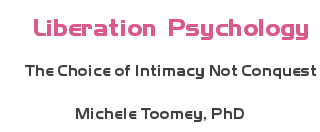Book: Table of Contents
© 2000 Michele Toomey, PhD
Introduction
Chapter 1: The Power of Language
- Exploration of the Effect Words Can Have on Us
- Presentation of How We Receive A Message and Reactions Are Triggered
- Example of How Reactions Can Violate or Liberate
- Using Words As Weapons or As Tools
- Summary and Activities
Chapter 2: How To Capture the Positive Force of Fairness
- What Is Fair and How Do We Know What's Fair
- Why Fair Is Such A Powerful Positive Force
- How Fair Matches Hostility and Anger
- The Effect Fairness Has On A Classroom and A School
- Summary and Activities
Chapter 3: What is Self-Expression with Accountability?
- Defining Accountability and What It Requires of Us
- Why Self-Expression with Accountability is So Important and Why We Should Teach It
- Questionnaire on How Family of Origin Expressed Feelings
- Discussion of Responses and How They Affect Current Patterns of Communication
- Self-Assessment of What Personally Needs to Be Learned and Changed to Be Able To Teach Accountability
- Summary and Discussion Questions
Chapter 4: Communicating with Ourselves and Others
- How Our Communication Network Works
- The Role of Confrontation in Preventing Abuse
- The Goal of Intimacy Not Conquest Has Its Own Power
- The Guiding Principles Governing Our Communication Network
- Summary and Activities to Demonstrate the Principles and How They Apply to An Educational Setting
Chapter 5: The Essential Need for Integrity
- Definition of Integrity and Contrasting It to Morality
- The Role Integrity Plays in Our Communication Network
- The Need For Integrity
- The Demands of Integrity
- The Gift of Integrity for the Students and the Teachers
- Summary and Discussion Topics
Chapter 6: Confronting Alienation
- Examining How Alienation Is Affected by Words
- Exploring How Alienation Gains Momentum and Affects Learning
- Discussing How Alienation Can Lead to Depression and Despair
- The Role of Drug and Alcohol Abuse As Non-Verbal Communication
- How Violence and Abuse Become An Issue with Alienation
- Summary and Activities
Chapter 7: Preventing and Dealing with Violence and Abuse
- The Difference Between Arguing and Conversing, Blaming and Claiming, Bullying and Cajoling
- The Importance of Timing in Preventing and Dealing with Abuse
- The Power of A Fair Confrontation with Accountability
- The Quieting Effect of Fairness and The Power It Has On Behavior
- The Necessity of Consequences and The Difference of Viewing Them As Consequences, Not As Punishment
- Summary, Activities, and Application
Chapter 8 Building A Sense of School As Community Through Fairness
- Viewing Confrontation As Explorations Not Accusations
- Approaching Life As A Journey Not A Test
- The Protection of Fairness
- The Gift of Understanding and Intimacy
- Developing A Sense of Place and Belonging
- Being Proud of Being A Student In Your Class and In Their School
- Summary and Activities
Chapter 9: How Gender Affects Self-Expression with Accountability
- Confronting the Stereotypes and Challenging Genderized Power
- The Price of Linking Masculinity to Violence
- Gender and Bullying: The Devastating Effects of Verbal As Well As Physical Abuse
- The Difficulty Each Gender Has In Confronting and Being Accountable
- The Difference in Girls Talking to Girls, Boys Talking to Boys, and Girls and Boys Talking
- Summary and Activities
Chapter 10: Education In A Communication Context
- What Does That Mean
- What Are the Benefits to You, Your Students, and Your School
- What Will It Demand of You, Your Students, and Your School
- Is It Worth It?
- Final Stages of Ongoing Project for Classroom Use
- Questionnaire on How Each One Feels About Teaching Confrontation with Accountability and What They've Learned About How to Teach It. Discussion.
Epilogue
Author's Final Thoughts |



